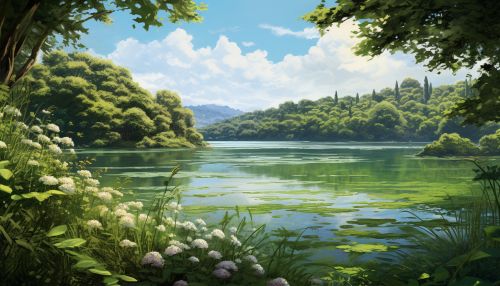Freshwater ecology
Introduction
Freshwater ecology is the scientific study of the distribution and abundance of organisms, as well as their interactions within freshwater environments. These environments include rivers, lakes, ponds, wetlands, and streams. Freshwater ecology is a branch of limnology, the study of inland aquatic ecosystems.
Freshwater Ecosystems
Freshwater ecosystems are a subset of Earth's aquatic ecosystems. They include lakes and ponds, rivers, streams, springs, and wetlands. They can be contrasted with marine ecosystems, which have a larger salt content. Freshwater habitats can be classified by different factors, including temperature, light penetration, nutrients, and vegetation. Freshwater ecosystems can be divided into lentic ecosystems (still water) and lotic ecosystems (flowing water).


Freshwater Organisms
Freshwater environments are home to a vast array of life forms, ranging from microscopic organisms such as bacteria and algae, to larger forms of life such as fish, birds, and mammals. These organisms are adapted to the unique conditions of their freshwater habitats, and their presence and activities have a profound impact on the physical and chemical characteristics of their environments.
Microorganisms
Microorganisms, including bacteria, viruses, and algae, play a crucial role in freshwater ecosystems. They are involved in nutrient cycling, decomposition, and the food chain. The study of freshwater microorganisms is known as aquatic microbiology.
Plants
Freshwater plants, also known as hydrophytes or macrophytes, are adapted to live in aquatic environments. They provide food and habitat for many organisms, and they also play a role in nutrient cycling and oxygen production. The study of freshwater plants is part of phycology, the study of algae, and botany, the study of plants.
Animals
Freshwater animals include a wide range of organisms, from microscopic invertebrates to large mammals. These animals are adapted to live in freshwater environments, and they play a crucial role in the ecosystem by participating in the food chain and contributing to the cycling of nutrients. The study of freshwater animals is part of zoology, the study of animals.
Freshwater Ecology Concepts
Freshwater ecology encompasses several key concepts, including the food web, nutrient cycling, and ecological succession. These concepts are crucial for understanding the dynamics of freshwater ecosystems and the interactions among their inhabitants.
Food Web
The food web in a freshwater ecosystem is a complex network of feeding relationships among organisms. It starts with primary producers like algae and plants, which are eaten by primary consumers (herbivores). These, in turn, are eaten by secondary consumers (carnivores), and so on. The study of food webs is part of trophic ecology.
Nutrient Cycling
Nutrient cycling is the process by which nutrients move through an ecosystem. In freshwater ecosystems, key nutrients include carbon, nitrogen, and phosphorus. These nutrients are cycled through the ecosystem via biological processes such as decomposition, respiration, and photosynthesis. The study of nutrient cycling is part of biogeochemistry.
Ecological Succession
Ecological succession is the process by which the structure of a biological community evolves over time. In freshwater ecosystems, this can involve changes in the types of organisms present, as well as changes in physical and chemical conditions. The study of ecological succession is part of community ecology.
Threats to Freshwater Ecosystems
Freshwater ecosystems are under threat from a variety of factors, including pollution, climate change, and habitat destruction. These threats can have a significant impact on the health and diversity of freshwater ecosystems, and they are a major focus of conservation efforts.
Pollution
Pollution is a major threat to freshwater ecosystems. This can come from a variety of sources, including industrial waste, agricultural runoff, and residential waste. Pollution can lead to a variety of problems, including eutrophication, acidification, and the introduction of toxic substances. The study of pollution and its effects on freshwater ecosystems is part of environmental science.
Climate Change
Climate change is another major threat to freshwater ecosystems. Changes in temperature and precipitation patterns can have a significant impact on freshwater ecosystems, affecting everything from water levels to the types of organisms that can survive. The study of climate change and its effects on freshwater ecosystems is part of climate science.
Habitat Destruction
Habitat destruction, often due to human activities such as deforestation and urban development, is another major threat to freshwater ecosystems. This can lead to a loss of biodiversity and changes in ecosystem function. The study of habitat destruction and its effects on freshwater ecosystems is part of conservation biology.
Conservation of Freshwater Ecosystems
Conservation of freshwater ecosystems involves efforts to protect and restore these ecosystems and their biodiversity. This can involve a variety of strategies, including pollution control, habitat restoration, and the establishment of protected areas. The study of conservation strategies and their effectiveness is part of conservation science.
